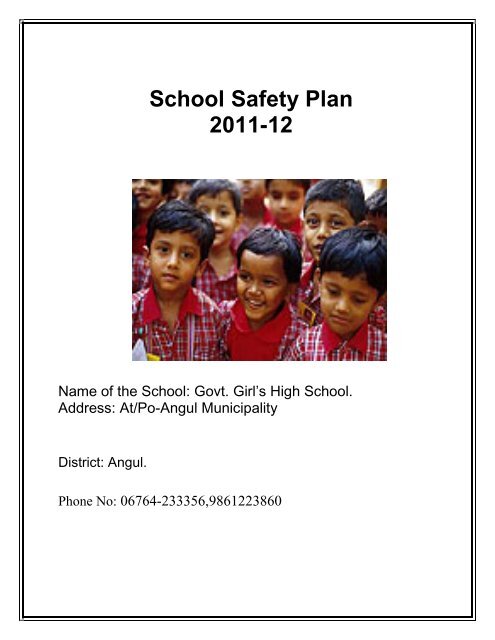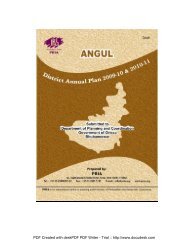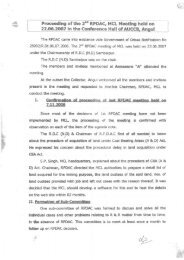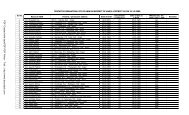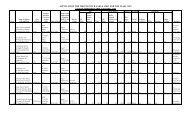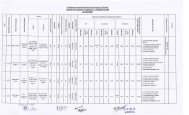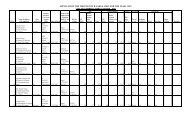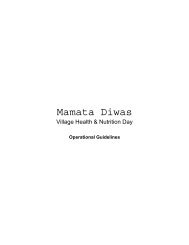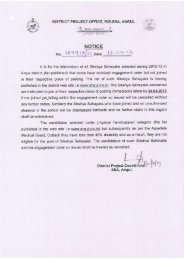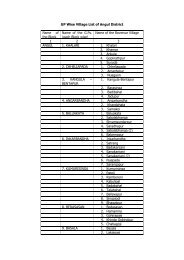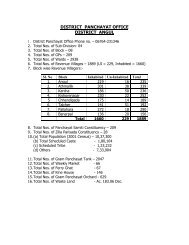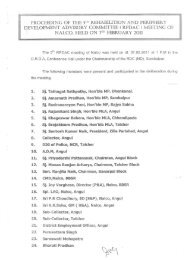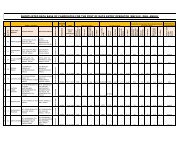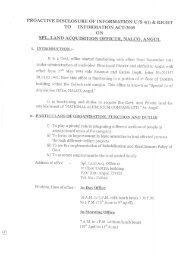SDMP Girls HS - Angul
SDMP Girls HS - Angul
SDMP Girls HS - Angul
Create successful ePaper yourself
Turn your PDF publications into a flip-book with our unique Google optimized e-Paper software.
School Safety Plan<br />
2011-12<br />
Name of the School: Govt. Girl’s High School.<br />
Address: At/Po-<strong>Angul</strong> Municipality<br />
District: <strong>Angul</strong>.<br />
Phone No: 06764-233356,9861223860
Content<br />
Chapter Topic<br />
1 Rationale and objectives<br />
2<br />
3<br />
4<br />
School at a glance<br />
PURPOSED SCHOOL SAFETY PLANNING<br />
School Emergency Response Plan<br />
School Safety Advisory Committee<br />
5 Risk Assessment<br />
6 Resources Mapping<br />
7<br />
08<br />
09.<br />
10.<br />
Emergency Response Teams<br />
Monitoring and Evaluation<br />
Mock Drill<br />
Annexures<br />
1<br />
Page Number
Chapter-1<br />
Rationale and Objectives<br />
The Hon’ble Supreme Court of India observed in Writ Petition (Civil) No- 483 of 2004<br />
(Avinash Mehrotra vs Union of India & others) that the education which is provided to<br />
children in School should be in the environment of safety. It has become imperative that<br />
each school must follow the bare minimum safety standards in addition to the compliance<br />
of the national Building Code of India, 2005. It has been observed that it is fundamental<br />
right of each and every child to receive education free from fear of security and safety.<br />
The children cannot be compelled to receive education from and unsound and unsafe<br />
building.<br />
It is needless to emphasize that children are vulnerable to various disasters that<br />
may affect the school. To reduce the vulnerability and impact of any eventual disasters, it<br />
has been suggested to prepared Emergency Response Plans (Disaster Management<br />
Plan), taking up awareness and capacity building programmes and conduct mock drills.<br />
This plan is designed to provide a framework for protecting students, staffs and<br />
school facilities, as well as to describe the responsibilities of staff members, for a wide<br />
range of emergency and disaster situations that may occur. This plan assumes that the<br />
school must be self-sufficient and may be required to provide shelter to the affected<br />
community nearby the school. The plan is to be initiated by the school and implemented<br />
by all the staffs and students. The plan prepared will be tested through mock drills and<br />
should be reviewed and updated annually.<br />
2
Chapter-2<br />
School at a glance<br />
• Name of School: Govt. Girl’s High School.<br />
• Management Authority: Deptt. of Mass Education(Schools),Orissa.<br />
• Name of the Head Mistress/ Principal:Ms. Jyotsna Mayee Sahoo.<br />
• Address of School:At/Po-<strong>Angul</strong> Municipality,District-<strong>Angul</strong>.<br />
• Phone Number: 06764-233356,9861223860<br />
• Location: Town/Ward/City Ward No-<strong>Angul</strong> Municipality.<br />
• Shift – Morning/ Afternoon/Day-Day Shift.(10am to 4 pm)<br />
• Total No of Classes /Standards-5 Classes.(VIth to Xth).<br />
• Total Class Rooms:<br />
• Total Toilet / Bath room (Floor wise): 02(Two Nos) Repair essential.<br />
• Number of Staircase:00.<br />
• Number of Exit/ outlet:02.<br />
• Laboratory (Location):00<br />
• Number of Teachers:<br />
• Number of Physical Instructor:P.E.T-01.<br />
• Number of Non -Teaching Staff:<br />
• Number of Students: Total Boys: <strong>Girls</strong>: ________<br />
• Number of Students with Special Needs:<br />
Station Locality Telephone Distance<br />
Fire station <strong>Angul</strong><br />
Municipality<br />
101 1 KM<br />
Health Centre DO 500 mtr<br />
Police station Do 500 mtr<br />
Ambulance Do 500 mtr<br />
Other Facilities Available:<br />
• Library Room: One Library Room.<br />
• Meeting Hall: Available.<br />
• Examination Hall : In Classrooms.<br />
• Scout & Guide / NCC Room/ Red Cross Room/ Junior Red Cross:<br />
No separate room for Scout & Guide/NCC/JRC and NCC.<br />
• Computer Lab: Computer ______ V-Sat Internet Connectivity ( Yes/No) : No.<br />
• Cycle Stand / Parking: The Cycle Stand Parking area is in damaged condition.<br />
3
PURPOSED SCHOOL SAFETY PLANNING<br />
Chapter-3<br />
School Emergency Response Plan<br />
The following procedures may be followed for preparation of School Emergency<br />
Response Plans/ Disaster Management Plan.<br />
• Formation of Disaster Management Committee<br />
• Risk Assessment<br />
• Resources Mapping<br />
• Formation of Disaster Management Teams<br />
• Networking with Stakeholders<br />
• Information Education and Communication (IEC ) activities<br />
• Plan of Action<br />
• Monitoring and Evaluation<br />
• Conduct of mock drill<br />
• Safety Tips<br />
The above steps are illustrative. These may be modified for preparation of school specific<br />
safety plans taking all relevant factors into consideration.<br />
4
Chapter-4<br />
School Safety Advisory Committee<br />
4.1 School Safety Advisory Committee may comprise the following members (suggestive)<br />
Sr.<br />
No<br />
Designation Name and Address Telephone No<br />
1 Head of the School Jyotsnamayee Sahu<br />
2 Teacher Pratima Kumari Mishra<br />
3 Teacher Sumitra Dash<br />
4 Teacher Ranjita Das<br />
5 Teacher Laxmipriya Sahu<br />
6 Member of Parent-<br />
Teacher<br />
Association<br />
Hara Mohan Majhi<br />
7 Member of Parent-<br />
Teacher<br />
Association<br />
Ranjubala Pani<br />
8 Councilor Bansidhar Pradhan,WN-15<br />
9 Smt. Binodini Das,WN-18<br />
10 Dharmunda Naik<br />
11 Narsima Bibi<br />
12. Rama Majari Sahu<br />
13. Sankar Sethi<br />
14. Dr. Bramahananda Sahu<br />
15. Dr. Chitanya Sahoo<br />
16. Rabindranath Sahu<br />
17. Suhasini Sahu<br />
18. Local NGO Mamata Mohaptra,ABCD<br />
19. Member selected<br />
by the school<br />
20. Member selected<br />
by the school<br />
The Committee will be constituted by the School and may be reconstituted annually/ as<br />
per requirement<br />
4.2 Roles and Responsibilities<br />
To have an understanding of the policy and planning principles, similar to that required<br />
for the development of curriculum or a student welfare policy. These members will<br />
help the school in preparation of the School Safety Plan (SSP)<br />
5
Evaluation of the School Safety Plan.<br />
Carrying out the mock drill twice a year.<br />
Updating of the plans at regular intervals (at least once in a year, and after any<br />
significant disaster) to ensure that the plan is workable.<br />
Look into the structural safety requirements of the school for various hazards<br />
(earthquake, fire, floods, cyclone, etc.).<br />
Get the school building assessed for the hazards identified and prompt remedial<br />
measures taken, as required.<br />
Earmark/ locate funds for carrying out preparedness and mitigation measures in the<br />
school through school funds, corporate sectors, civil societies and establishing<br />
linkages with various departments and organizations working in the field of disaster<br />
management.<br />
Coordinate with stakeholders during a disaster.<br />
Media management.<br />
Mobilize assistance and any external support in case necessary for those who have<br />
taken shelter in the school (children and if outsiders)<br />
Identify shelter places for the school children and also for outsiders in case necessary.<br />
Observation of Fire Safety Day on 14 th April every year.<br />
6
Chapter-5<br />
Risk Assessment<br />
5.1 Past Disaster events affecting the school and /or the nearby community (if any)<br />
Disaster Event Year/date<br />
Occurrence<br />
of Summary description of impact<br />
Cyclone/ Hail storm 12 th April 2002 Teachers Quarters<br />
5.2 Probable hazards, which may affect the school may be identified<br />
5.3 Hazard Analysis<br />
Probable Hazards<br />
1.Road Accident<br />
2.Heat Wave/ Sun Stroke<br />
3.Electricity Short Circuit<br />
4.Earthquake<br />
5<br />
6<br />
7<br />
8<br />
9<br />
10<br />
• Take into account past and probable disasters<br />
• Structural Hazards: School Building / Water tank / Electric Installation / Windows / Basements<br />
etc.<br />
• Class room Hazards : Heavy loose objects / hanging objects / Chemical in laboratories /<br />
Aquarium etc<br />
• Maintenance Hazards: unskilled maintenance of equipment / articles etc.<br />
• Neighborhood Hazards: Hazards industries/petrol pumps/ gas depots/ high-voltage power lines/<br />
major traffic routes/ multi-storey buildings vulnerable to collapse/ water towers/ landslide areas.<br />
• Flooding from rivers<br />
Which may affect the entire area<br />
Which may affect limited area<br />
Which may affect the entire schools<br />
Which may affect a portion of the schools<br />
• Fire hazards, earthquake etc<br />
7
5.4 Seasonality of Hazards<br />
Hazard Months<br />
Jan Feb Mar Apr May Jun Jul Aug Sep Oct Nov Dec<br />
Flood<br />
Cyclone<br />
Earthquake<br />
Fire<br />
Heat wave<br />
5.5 Examination of Schools building: (Check List)<br />
Sl. No. Check List YES/NO Comment<br />
1 Are the corridors and stairwells clear of any<br />
obstruction<br />
Yes<br />
2 Does the school have provision for<br />
emergency power back-up<br />
No<br />
3 Are the fans and lights properly fixed to the<br />
ceiling<br />
Yes<br />
4 Are there any open electric wire No<br />
5 Do the doors of all classes open outwards Yes<br />
6 Are window and balconies covered Yes<br />
7 Does the school have minimum two exits/<br />
Alternative exits<br />
Yes<br />
8 Are all exits from the school clear Yes<br />
9 Is there adequate arrangement for fire<br />
safety<br />
10 Are Fire Extinguishers in working condition<br />
11 Are there adequate amount of Sand Bags<br />
8<br />
No<br />
No<br />
No<br />
12 Is there Water storage facility available No<br />
13 Are there Water Pipes Yes<br />
14 Are there Water Pumps Yes<br />
15 Is adequate water/toilet facility available at<br />
each floor<br />
Yes<br />
16 Are staircases functional at all time or some<br />
exits are kept locked<br />
No<br />
17 Are there any thatched rooms ? No
5.6 Assessment of School Building<br />
i) Architectural Observations<br />
Sl. No Check List YES/NO<br />
1 Age of the building<br />
2 Does the buildings<br />
retrofitted<br />
No<br />
3 Does the building have a<br />
Building Use Certificate?<br />
No<br />
4 Construction History (one<br />
phase or multiple phase)<br />
No<br />
5 Soft storey Yes<br />
6 Column Orientation No<br />
7 Shape of building Square<br />
8 Are there cracks in<br />
structural elements<br />
Yes<br />
9 Are the cracks repairable? Yes<br />
10 Are major repair works<br />
carried out for the<br />
strengthening or the<br />
damaged part of the<br />
building<br />
Structural Observations<br />
Sl. No Check List<br />
1 Space in each class rooms<br />
Height<br />
Area per person<br />
Yes<br />
2 Location of the staircase No<br />
Distance of the staircase from the<br />
farthest room<br />
3 Staircase details<br />
Width of the staircase<br />
Tread<br />
9<br />
40 students capacity<br />
No<br />
Details<br />
Details
Riser<br />
No of risers per flight<br />
Minimum headroom in a passage<br />
under landing of a staircase<br />
Railing Height<br />
4 Passage/Corridor 8ft<br />
Width of corridor<br />
Length of the corridor<br />
5 No of exits Two<br />
Type of exit<br />
(doorway/corridor/passageway)<br />
Condition of the exit route e.g.<br />
obstructions if any<br />
ii) Functional/Operational Observations: (Give detail description)<br />
1. Condition of the Electrical panels/mains?Good<br />
2. Lightning Protection of buildings?Nil<br />
3. Distance of Emergency Service from the school.1 K.M Approx<br />
4. Special Provisions for physically handicapped No<br />
10
iii) External Observation:<br />
Sl.<br />
No.<br />
Description YES/NO Details<br />
1 Any hazardous unit near the<br />
vicinity<br />
Yes<br />
2 Means of access Close<br />
Proximity<br />
3 Traffic conditions on the road Densed<br />
4 Speed Breakers Nil<br />
5 Caution sign boards Nil<br />
6 Encroachment near the entrance<br />
of the building<br />
No<br />
7 Chances of water logging No<br />
8 Drains & open drains Yes<br />
9 Access of fire engine Yes<br />
10 Threat against falling of adjoining<br />
buildings/ compound walls/<br />
parapet walls/ chimneys/tall<br />
structures/ electricity poles etc<br />
No<br />
11 Open space Yes<br />
12 All round open space Yes<br />
13 Main entrance to the plot Yes<br />
14 Distance between two blocks or<br />
Separation between accessory<br />
and main building<br />
20 Ft.<br />
15 Foot path width / Pathway Yes<br />
11
5.7 Vulnerability of Students / teachers /Non-Teaching staff<br />
Category Total Men/Boys Women/<strong>Girls</strong> PwDs/others<br />
Students<br />
Teacher 22<br />
Non-Teaching<br />
staff<br />
7<br />
Details of class wise position and names of students / teachers/ non-teaching staff with<br />
disabilities and needing special attention are given in Annexure-III<br />
12
Chapter -6<br />
Resources Mapping<br />
6.1 Resources available in the schools<br />
Sl No Item Yes/No If yes, indicate<br />
numbers<br />
1 No of building blocks One<br />
2 No of class rooms 19<br />
3 Staircase with ramps Nil<br />
4 Fire Extinguishers with ISI<br />
No<br />
marks<br />
5 First Aid kits No<br />
6 Water Tanks Yes<br />
7 Tube wells Yes<br />
8 NCC Unit Yes<br />
9 Scouts and Guide Unit Yes<br />
10 Staff/student trained in First aid<br />
techniques<br />
No<br />
11 Staff/student trained in search No<br />
and rescue techniques<br />
12 Play Ground Yes<br />
13 Open space Yes<br />
14 Long halls Yes<br />
15 Auditorium No<br />
15 Ropes No<br />
16 Big Containers No<br />
17 Ladders No<br />
18 Stretcher No<br />
19 Internet Connectivity No<br />
20 Telephone Yes<br />
21 TV No<br />
22 Radio No<br />
23 School Bus No<br />
24 School Vehicle Yes<br />
13
6.2 Details of teachers<br />
Sl No Name of the Teaching staff<br />
and Address<br />
Details Contact number<br />
1 Jyotsnamayee Sahu HM<br />
2 Pratima Mishra Teacher<br />
3 Sabita Mohanty do<br />
4 Premalata Satapathy Do 9437334016<br />
5 Sugati Manjari Mohanty Do 9437082444<br />
6 Amiya Kumar Nayak Do 9861331542<br />
7 Sumitra Dash Do<br />
8 Ruchismita Mohanty Do<br />
9 Manasi Nanda Do 9861588945<br />
10 Ranjita Das Do<br />
11 Laxmipriya Sahu Do<br />
12 Sumita Das Gupta Do<br />
13 Hillolini Mishra Do<br />
14 HiranyaPrava Tripathy Do<br />
15 Mounabati Pattnaik Do<br />
16 Sanjukta Mishra Do<br />
17 Priyam Bada Pattnaik Do<br />
18 Snehalata Diwedi Do<br />
19 Bijyalaxmi Bahanja Do<br />
20 Priyambada Pradhan Do<br />
21 Rashmita Behera Do<br />
22. Pragyan Sahu Do<br />
6.3 Details of Non-Teaching Staff<br />
Sl No Name of the non- teaching<br />
staff and Address<br />
1 Sukanta Kumar Dash<br />
2 Kulamani Sahu<br />
3 Basanti Dei<br />
4 Gundicha Behera<br />
5 Kamalini Biswal<br />
6 Soukini Patel<br />
Position Contact Number<br />
Office<br />
Assistant<br />
Night<br />
Watchman<br />
Peon<br />
Peon<br />
Peon<br />
Peon<br />
7 Chitta Ranja Mishra Peon<br />
14
Chapter -7<br />
Emergency Response Teams<br />
The school may form following Emergency Response Teams to handle emergency situations that<br />
may occur during school hours:<br />
i. Awareness Generation Team<br />
Sl. No. Name of the Teachers<br />
/Student<br />
Class Sec Position in the team<br />
1 Manasi Nanda (Tr.)<br />
Team Leader<br />
2 Sonali Sahu St.<br />
3 Bubul Begum St.<br />
15<br />
IX C<br />
IX C<br />
4. Jayshree Dehury IX A<br />
5. Sipanjali Sahu IX B<br />
6. Titali Sahu IX C<br />
Responsibility of the Team<br />
Members<br />
Pre During Post<br />
• Generate Awareness among the<br />
Students and Teachers on Disaster<br />
Preparedness through Orientation<br />
Program, News Scripts, Books, and<br />
Internet<br />
• Organize Competitions on Day<br />
observations<br />
• Develop IEC Materials<br />
• Aware the students on DO’S and<br />
DON’TS of Disasters<br />
• Council the Students<br />
on not to panic<br />
• Aware the students on<br />
DO’S and DON’TS of<br />
Disasters<br />
Resources Required<br />
Resource Name If not Available, where to Bring<br />
1. IEC Materials From District Office, District Medical, Red Cross etc<br />
2. Projector and Computer Available in the School<br />
3. Auditorium / Meeting Hall Available in the school<br />
4. Information Internet, District Emergency Operation Center<br />
5. Manuals District Emergency Operation Center<br />
6. Internet Available in School<br />
ii. Warning Dissemination Team<br />
Sl. No. Name of the teachers /Student Class Sec Position in the team<br />
1<br />
Amiya Kumar Nayak<br />
Team Leader<br />
2 Chinmayee Dibya Puspa IX A<br />
3 Juktashress Dehury<br />
IX A<br />
4. Suchismita Sahu IX A<br />
5. Mansmita Sahu IX A<br />
6. Amrita Nayak IX C<br />
Members
Responsibility of the Team<br />
Pre During Post<br />
• Develop and Practice Chain of Command • Issue Warning after confirmation • Watch the situation<br />
• Prepare list of Warning dissemination • Inform concerned authority like over Television, Radio<br />
equipments<br />
Fire Station in case of Fire and District EOC<br />
• Training of the team members<br />
Accident.<br />
• De-warning<br />
• Finalize the Warning medium and inform • Council students not be panic.<br />
to all<br />
• Alert Evacuation, S&R and First<br />
• Finalize the Safest Places and Inform to<br />
all<br />
• Collect information from authenticated<br />
source like District EOC, Internet, TV<br />
News etc<br />
Resources Required<br />
Aid Teams<br />
Resource Name If not Available, where to Bring<br />
1. Bell/ Whistle / Siren Available in the School<br />
2. Internet Available in the School<br />
3. Television/ Radio Available in the School<br />
4. School Maps Available in the School<br />
5. List of Important Telephone Nos. Available in the School<br />
6. List of Students class wise and Monitors & Class Teachers Available in the School<br />
iii. Evacuation Team<br />
Sl. No. Name of the teachers /Student Class Sec Position in the team<br />
1 Sumitra Dash<br />
Team Leader<br />
2<br />
3<br />
4<br />
5<br />
16<br />
Members<br />
Responsibility of the Team<br />
Pre During Post<br />
• Training of the team • Maintain Discipline and<br />
members<br />
evacuate as per the earlier<br />
• Develop and Practice Chain plan<br />
of Command<br />
• Alert Search & Rescue<br />
• Prepare Evacuation Route (S&R) and First Aid (FA)<br />
chart/ Alternate Route Map<br />
for both the floor<br />
• Keep Ladders Ready<br />
• Keep Important Telephone<br />
numbers<br />
Team members
• Know the Safe Places<br />
available and keep the<br />
location map of the school<br />
• Mock drill and improve the<br />
Plan if failed.<br />
Resources Required<br />
Resource Name If not Available, where to Bring<br />
1. Ladder<br />
2. Evacuation Map with alternate Route<br />
3. List of Safe Places<br />
4. Important Telephone Numbers<br />
5.<br />
6.<br />
A suggestive plan for evacuation is given in Annexure-IV.<br />
iv. Search & Rescue Team<br />
Sl. No. Name of the teachers /Student Class Sec Position in the team<br />
1<br />
Sumita Das Gupta<br />
Team Leader<br />
2 Sweta Siran Majhi<br />
IX A<br />
3 Suchismita Jena<br />
4 Arpita Das<br />
5 Subhashree Saya<br />
17<br />
IX A<br />
IX B<br />
IX C<br />
6. Sibasrita Priyadarshini Nayak IX C<br />
Members<br />
Responsibility of the Team<br />
Pre During Post<br />
• Training of Team members • Take necessary Precautions<br />
and Practice<br />
and start operation<br />
• List out the equipments • Alert First aid team<br />
required and keep ready for<br />
the operation<br />
members<br />
• Linkage with Fire Dept,<br />
District EOC for Equipments<br />
and other support<br />
• List of Vulnerable Groups<br />
• List of Students class wise,<br />
Monitors<br />
Teachers<br />
• Mock drill<br />
and Class<br />
Resources Required
Resource Name If not Available, where to Bring<br />
1. Ropes & Pulleys<br />
2. Ladders<br />
District EOC<br />
3. Fire Extinguisher District EOC/ Fire Station<br />
4. Rubber Gloves Fire Station<br />
5. Stretchers District EOC/ Fire Station/ Medical<br />
v.<br />
6. Life Jackets and Buoys District EOC/ Fire Station<br />
First Aid Team<br />
Sl. No. Name of the teachers /Student Class Sec Position in the team<br />
1<br />
Ranjita Das<br />
Team Leader<br />
2 Manisha Sharma<br />
IX B<br />
3 Riyanka Proiyadarshini Pradhan<br />
4 Sindha Sunita Pattnaik<br />
18<br />
IX B<br />
IX C<br />
5. Soumyajyoti Pradhan IX A<br />
6. Bandana Pani IX B<br />
Members<br />
Responsibilities of the Team<br />
Pre During Post<br />
• Training of Team members and Practice • First Aid to the casualties<br />
• List out the equipments required and<br />
keep ready for the operation<br />
• Linkage with Fire Dept, District EOC for<br />
Equipments and other support<br />
• List of Vulnerable Groups<br />
• List of Students class wise, Monitors and<br />
Class Teachers<br />
Resources Required<br />
Resource Name If not Available, where to Bring<br />
1. First Aid Box<br />
Common First Aid Procedures in General Practice<br />
First Aid is the provision of limited care for an illness or injury, which is provided to a sick or<br />
injured patient until definitive medical treatment can be accessed, or until the illness or injury is<br />
fully dealt with. It generally consists of series of simple, sometimes life saving, medical<br />
techniques, that an individual can be trained to perform with minimal equipment. The principle of<br />
first aid is immediate action, but it is essential that quick action does not cause panic.<br />
• Any action taken needs to be careful and deliberate and the first-aider must remain calm at all<br />
times.
• It is equally important to assess the situation quickly, to appreciate the limitations of your own<br />
actions and to seek expert assistance (e.g. calling 100 when necessary for ambulance, fire<br />
brigade, or police) as soon as possible.<br />
• The first priority is to yourself and others - protect the scene after assessing risk, and think<br />
before you act (there may be gas - risk of asphyxiation/explosion, electricity - the pool of water<br />
round the faulty washing machine may be live, fire - opening a hot door may be the last thing<br />
you do, assault - the assailant with knife or gun may be behind the door awaiting his next<br />
victim or a hostage, blood - avoid unnecessary contact with body fluids by wearing gloves).<br />
Fractures and dislocations<br />
• Immobilize the affected area (especially the neck if there is any possibility of an injury to the<br />
cervical spine).<br />
• Keep the patient still and support the injured area.<br />
• For arm fractures a sling can be made to support and immobilize the affected area.<br />
• Splints (any long firm object) can be used for support and immobilization but ideally splint the<br />
affected area to another part of the body when appropriate, e.g. using one leg to splint the<br />
other leg.<br />
• For open fractures, control the bleeding with a sterile dressing and apply pressure if required.<br />
RICE procedure:<br />
Strains and sprains<br />
• R - Rest and support affected limb<br />
• I - Apply Ice or a cold compress to reduce swelling<br />
• C - Compress by applying gentle, even pressure on the limb; pad the affected limb<br />
with foam or cotton wool, secured with a bandage<br />
• E - Elevate limb to reduce blood flow to affected area<br />
Burns are classified as:<br />
Burns<br />
• Superficial; only damage the outer layer of the skin; cause reddening of the skin.<br />
• Partial thickness; damage the epidermis layer of the skin; cause blistering.<br />
• Full thickness: damage all the layers of the skin and underlying tissue.<br />
Treatment<br />
19
• Extinguish flames by water, extinguisher, or smothering.<br />
• Remove any continuing source of heat, removing non-adherent clothing/plastic.<br />
• Immediately submerge the affected part in cold water for at least 10minutes (20 minutes<br />
for chemical burns).<br />
• Remove jewellery or release tight clothing that may act as tourniquet.<br />
• Cover with a clean, non-stick sterile dressing (Clingfilm or plastic bags may be used).<br />
• DO NOT: break blisters or use any lotions or creams.<br />
• If electrical burn actively seeks other entry/exit wound.<br />
• Keep patient warm, do not let overzealous cooling of the burn exacerbate shock.<br />
• The patient should be seen by the practice nurse and/or doctor and, depending on the<br />
severity of the burn, may need to be sent for treatment in hospital<br />
Nosebleeds<br />
• Only 10% of patients with epistaxis seek medical attention, and 80% of these have<br />
anterior nose bleeds (from Little's area).<br />
• Use sterile disposable gloves, and face shield if possible (nasal bleeding is one of the<br />
commonest emergencies to put medical staff at risk of blood contamination, and the<br />
conjunctivae are potential sites for the transmission of HIV).<br />
• Get the casualty to sit down, lean slightly forward and pinch the fleshy part of the nose,<br />
and push against the bony parts of the face. They should breathe through their mouth,<br />
spitting out blood to avoid choking, and aid assessment of control of blood loss.<br />
• The pressure and posture should be maintained for at least 10 minutes but a longer time<br />
may be required.<br />
• Ice packs to adjacent cheeks/face may be applied but conflicting evidence of<br />
effectiveness.<br />
• Uncontrollable epistaxis and posterior epistaxis should be referred to hospital.<br />
If a second or permanent tooth is knocked out:<br />
• Use sterile disposable gloves if possible.<br />
Tooth knocked out<br />
• Hold the crown of the tooth and not the root. Do not scrape the root to remove dirt.<br />
• Rinse the tooth immediately with milk or saline solution.<br />
20
• If possible and safe (i.e. person is not a child or reduced consciousness) then replace the<br />
tooth gently into its socket, and bite down on a gauze pad or handkerchief to help keep it<br />
in place. Care must be taken not to swallow the tooth.<br />
• If the tooth cannot be reinserted then put it in whole milk or saliva, and control bleeding<br />
with a gauze pad inserted in the tooth socket with the person biting gently on the pad.<br />
• If the gums are bleeding, put cold water on a piece of gauze and push it between the lips<br />
and gums.<br />
• The person should see a dentist as soon as possible, ideally within 20 minutes, as the<br />
tooth begins to die after 15 minutes.<br />
If a primary tooth (likely if the child is under the age of 7) is knocked out or the gum injured:<br />
• Put on disposable gloves.<br />
• Control bleeding by soaking a piece of gauze in cold water and applying pressure to the<br />
site.<br />
• Treatment may not be necessary but the child should see a dentist to assess whether<br />
there is a need for realignment or the removal of a very loose tooth.<br />
Convulsions<br />
• A convulsion (violent, involuntary contraction or muscle spasm) can be caused by epilepsy<br />
or sudden illness.<br />
• Most convulsions are often followed by a period of unconsciousness or sometimes another<br />
convulsion.<br />
Treatment<br />
• Lay patient on ground in safe area.<br />
• Clear all objects away from the victim and place something soft under his head.<br />
• Do not place anything between his teeth or in his mouth.<br />
• Loosen tight clothing, particularly round the neck.<br />
• Do not give the victim any liquids.<br />
• Stay calm and keep the victim comfortable until help arrives.<br />
External bleeding<br />
• Use sterile disposable gloves, and face shield if possible.<br />
• Calm and reassure patient.<br />
• Lay patient down, to avoid fainting.<br />
21
• Check the wound for any foreign material, but do not remove deeply penetrating objects<br />
but pad and try to immobilize them.<br />
• Apply firm direct pressure using a clean, folded cloth over the injured area. If blood soaks<br />
through, do not remove it but cover that cloth with another one and continue to apply<br />
pressure to the wound for 7-10 minutes.<br />
• Elevate the injury. Position the wounded part of the body above the level of the heart if<br />
possible while you apply direct pressure.<br />
• If direct pressure and elevation do not sufficiently slow the blood flow, apply pressure to<br />
the closest pressure point. An essential part of first aid training is to learn how to locate the<br />
various pressure points of the body.<br />
• On very rare occasions when everything listed above has failed, you should apply a<br />
tourniquet proximal to the wound. Once a tourniquet is applied, it should not be loosened<br />
or removed until the victim has reached medical help. If you use a tourniquet, write down<br />
somewhere on the victim the time it was applied, so medical personnel will know how long<br />
it has been in place.<br />
• Further management will depend on the source and extent of the bleeding.<br />
Fainting<br />
Faints are a sudden brief loss of consciousness followed by full recovery within two minutes.<br />
Treatment<br />
• Lay the casualty flat with the legs raised.<br />
• Loosen restrictive clothing around the neck, remembering over-zealousness in the<br />
absence of witnesses could leave you open to an assault charge.<br />
• Check airway, breathing, and pulse.<br />
• If patient has vomited, put in recovery position to prevent choking.<br />
• There is usually a full recovery when laid flat. If this does not occur then further expert<br />
medical help is required.<br />
22
Chapter- 8<br />
Monitoring and Evaluation<br />
The activities planned and how fare it has been implemented in the school, a monitoring and<br />
evaluation committee taking members from PTA, School management authority, students and<br />
non teaching staffs will be formed. The team will monitor the activities regularly and evaluate in<br />
annually. The committee will write a report on the activities, its status and lesson learnt, which will<br />
be placed to the authority,<br />
S.N<br />
1<br />
2<br />
3<br />
4<br />
5<br />
6<br />
7<br />
Monitoring and Evaluation committee<br />
Name of the Committee member<br />
23<br />
Designation<br />
Chairman<br />
Member<br />
Member<br />
Member<br />
Member<br />
Member<br />
Member
Chapter -11<br />
Mock Drill<br />
After preparation of School safety plan and training of DMTs on various aspects, Mock Drills may<br />
be organized to demonstrate the preparedness strategies adopted. Hence School Safety Advisory<br />
Committee has to decide on conducting mock drills (preferably at least twice in a year)<br />
11.1 Preparedness Observations (Revision):<br />
Sl.<br />
No<br />
Check List YES/NO Comment<br />
1 Are awareness programmers<br />
2<br />
organized for the students and the staff<br />
Are teachers and students aware of the<br />
vulnerability or vulnerable areas in the<br />
school<br />
3 Are mock-drills performed regularly in<br />
the schools<br />
4 Safe place/shelters identified in the<br />
school<br />
5 Assignment of duties and<br />
responsibilities to the staff (S.O.P)<br />
6 Are staff trained for the first-aid<br />
7 Provision for fire-fighting systems<br />
8 Is public addressed system in working<br />
condition?<br />
9 Responsibility to update the plan<br />
given? To whom?<br />
10 Is plan copy is shared with each<br />
teachers and committee members.<br />
11 Is plan copy display on each floor on<br />
notice board<br />
11.2 Procedures for planning earthquake drills for schools<br />
Earthquakes are unpredictable events of nature. They may be slight tremors, which are hardly felt<br />
by anyone, or great events of destruction, which can cause the death of hundreds of people. As a<br />
result of the potential threat that this natural event has on the lives of people across the world it is<br />
most important that we are prepared to survive during this unpredictable event.<br />
Schools house up to hundreds of students each day and, as such, the threat of an earthquake is<br />
very great. It is most important that schools undertake regular earthquake drills, which will help to<br />
familiarize both students and staff to the ways in which to survive during an earthquake. The<br />
following are the recognized procedures by which an earthquake drill is planned and undertaken<br />
in schools.<br />
STEPS IN PLANNING AN EARTHQUAKE DRILL<br />
There are six (6) recognized components of an earthquake drill. These are:<br />
1. The alarm phase<br />
24
During this phase students and staff are alerted by a loud warning device, most likely the school<br />
bell. This must be a pre-arranged signal known by all so that the response will be immediate.<br />
2. The response phase<br />
In this phase everyone should head for cover - students should get under their desks, tables,<br />
chairs or under the door jamb. They should make sure to move away from windows, glass or light<br />
fixtures, which pose a serious threat to the student if it should break or get loose. If there is no<br />
cover available then the student should crouch and try to protect his/her head.<br />
3. The evacuation phase<br />
After remaining in each respective safe-place until the shaking stops, students and teachers<br />
should then evacuate the school building(s). The evacuation proceeds through pre-determined<br />
safe routes and the evacuees should then gather outside in a safe area, away from buildings. For<br />
instance, this safe area can be the playfield, the netball court or the basketball court, once the<br />
area is away from buildings, trees and even poles. This safe area is called the assembly point.<br />
4. The assembly phase<br />
At the assembly point the evacuees must be grouped in order. For example, classes are grouped<br />
together and even further grouped in alphabetical order or in order as they appear in their<br />
respective classrooms.<br />
5. The head count phase - otherwise called the roll call phase.<br />
During the head count phase teachers determine if everyone is present. This can be done by<br />
calling from the register the names of students and ticking off those present. In the event of a real<br />
earthquake, a search and rescue team would have to be dispatched to look for those who are<br />
missing.<br />
6. The evaluation<br />
After the head count there should be an evaluation, where the school identifies the snags in the<br />
drill, problem areas or potential problem areas and then can further aim to rectify these problems<br />
for a future earthquake drill.<br />
Once these steps are taken in planning an earthquake drill then students and school staff will be<br />
more prepared for the unpredictable strike of an earthquake and loss to life and limb will be<br />
lessened.<br />
11.3 Procedure for planning fire drills for schools<br />
In less than 30 seconds a small flame can be completely out of control and turn into a major fire.<br />
Room temperatures in a developing fire can be 60 0 C at floor level and 300 0 C or more at eye<br />
level. Inhaling of this hot air will damage the lungs also.<br />
Within less than three minutes room temperature can get so high that all the things present there<br />
ignite at once. This sudden ignition is known as flashover, which can be fatal to everyone<br />
present.<br />
25
FOR OWN SAFETY ONE SHOULD KNOW:<br />
1. One should read the operating instructions if you have fire alarm systems.<br />
2. One should read the operating instructions on the body of the fire extinguishers, provided<br />
on the floor.<br />
3. One should know the nearest exit from your table.<br />
4. Assembly point on ground floor or in the open.<br />
a. If any exit door/ route in obstructed by loose materials, goods, boxes etc. Also keep a<br />
spare key of the exit in a box next to the exit.<br />
b. If any staircase door does not close automatically, or does not close completely.<br />
c. If any fire extinguisher is obstructed, damaged or, apparently out of order.<br />
IF A FIRE IS DISCOVERED:<br />
1. In case of Fire for one’s own protection and for others one should report to Head of<br />
EARLY WARNING TEAM.<br />
2. Attack the fire with extinguishers provided in different floors.<br />
3. Evacuate if one is asked to do so.<br />
IF YOU HEAR EVACUATION INSTRUCTIONS:<br />
1. Leave the floor immediately by the south/north staircase.<br />
2. Report to Class teacher at your predetermined assembly point outside the building.<br />
3. Do not try to use the lifts.<br />
4. Do not run abruptly.<br />
5. Do not stop to collect personal belongings.<br />
6. Keep the lift lobby and staircase doors shut.<br />
Annexure<br />
Annexure-V: Important Telephone Numbers<br />
Annexure-VI: Disaster Safety Tips<br />
Annexure- Important Telephone Numbers<br />
Sl. No. Name of the important Offices/ Institutions Telephone Numbers<br />
1 District Magistrate & Collector Office-<br />
Fax -<br />
Res. -<br />
2 District Emergency Operation Center Toll Free- 1077<br />
3 Nearest Police Station, Toll Free-100<br />
26
4 Fire Station Toll Free –101<br />
5 District Hospital/ Nearest hospital/<br />
6 Nearest Nursing Home<br />
7 Municipality<br />
8 Ambulance 102,<br />
9 CI Of Schools<br />
10 DI of Schools<br />
11 District Red Cross Branch<br />
12 Local NGO-<br />
12 PTA<br />
13 Teachers<br />
14 Parents ( Doctor , Engineers, Ex –service man)<br />
15 State emergency Office<br />
16 Revenue Department<br />
17 Civil Defence<br />
Annexure- Disaster Safety Tips<br />
DO’S & DON’T’S FOR DISASTERS<br />
FLOOD<br />
Do’s Don’ts<br />
• Tune to your local radio for warnings<br />
and advice.<br />
• Move vehicles, equipments, garbage,<br />
chemicals, old persons, children,<br />
pregnant women etc. to higher and<br />
safe places.<br />
• Disconnect all electrical appliances.<br />
• Turn off electricity and gas before you<br />
leave the house.<br />
CYCLONE<br />
• Don/t allow children to ply in, or near, flood<br />
waters.<br />
• Never wander around in flooded area.<br />
• Don’t drive into water of unknown depth and<br />
current.<br />
• Don’t eat food, which is affected by<br />
floodwater.<br />
Do’s Don’ts<br />
• Stay indoor and take shelter in the • Beware of fallen power lines, damaged<br />
27
strongest part of your house.<br />
• Listen to the radio and follow<br />
instructions.<br />
• Find out shelter if you are caught out<br />
in the open.<br />
• Disconnect all electrical appliances<br />
and turn off gas.<br />
• If you have to evacuate, don’t return<br />
until advised.<br />
HEAT STROKE<br />
bridges and structures.<br />
• Play attention to all warnings and don’t go for<br />
sight seeing.<br />
• Wear strong shoes and clothing for<br />
protection.<br />
Do’s Don’ts<br />
• Postpone outdoor activities.<br />
• Avoid too much sunshine.<br />
• Wear headgear / turban / cap &<br />
Sunglasses.<br />
• Keep heat outside and cool air inside.<br />
• Drink plenty of fluid even if you do not<br />
feel thirsty.<br />
• Take frequent breaks if you must work<br />
outdoors.<br />
• For labourers working in the open,<br />
timings to be made morning and<br />
evening.<br />
• Don’t go outside in empty stomach.<br />
• Don’t go in extreme heat.<br />
• Don’t sit in a cool shower after coming in<br />
from hot temperature.<br />
• Don’t eat high protein food.<br />
• Don’t leave children or pet animal alone in<br />
closed vehicles.<br />
TORNADO<br />
Do’s Don’ts<br />
• Listen to the Radio/ Tv/ Public<br />
Addressing System for advance<br />
information and advice.<br />
• Turn off Electricity<br />
• Keep away from Old, Tall or<br />
ditched buildings, electricity wires,<br />
slopes and walls, which are liable<br />
to collapsed.<br />
• Do not run and do not wander round the<br />
streets.<br />
• Keep away from buildings, walls, slopes,<br />
electricity wires and cables & stay in the<br />
vehicle.<br />
EARTHQUAKE<br />
Do’s Don’ts<br />
• Keep away from old, tall or<br />
detached buildings, electricity<br />
wires, slopes and walls, which are<br />
liable to collapse.<br />
• Stop the vehicle away from<br />
buildings, walls, slopes, electricity<br />
wires and cables.<br />
• Leave your badly damaged<br />
house.<br />
• Collect water containers, food<br />
• Don’t rush to the doors or exits, never use<br />
the lift.<br />
• Keep away from broken windows, mirrors,<br />
chimneys and furniture.<br />
• Avoid places where there are loose electric<br />
wires and do not touch any metal object in<br />
contact with them.<br />
• Don’t re-enter badly damaged buildings and<br />
don’t go near damaged structures.<br />
28
items and ordinary and special<br />
medicines (for persons with heart<br />
complaints, diabetes etc.)<br />
Fire Accident<br />
Do’s Don’ts<br />
Do keep the phone number of the Fire<br />
Service near the telephone and ensure that<br />
everyone in the family knows the number.<br />
Do keep matches and lighters away from<br />
children.<br />
Do sleep with your bedroom closed to<br />
prevent the spread of fire.<br />
Do turn off the lights before leaving the<br />
house or going to bed; a short could start a<br />
fire.<br />
Do check tree lights for broken or cracked<br />
sockets, frayed wires, or loose connections.<br />
Do blow out candles before going to bed.<br />
Do use broad-based ones instead of tall, thin<br />
ones, which can tip over easily<br />
Do choose only "fire retardant" artificial<br />
trees.<br />
Do keep your tree hydrated, which makes it<br />
less likely to catch on fire. Cut off a half inch<br />
from the bottom of the trunk when you get<br />
home, and make sure the water level never<br />
falls below the base of the tree.<br />
Do have an adult always present when<br />
cooking is going on the kitchen. Children<br />
should not be allowed alone.<br />
Do keep hair tied back and do not wear<br />
synthetic clothes when you are cooking.<br />
Do make sure that the curtains on the<br />
window near the stove are tied back and will<br />
not blow on to the flame or burner.<br />
Do check to make sure that the gas burner is<br />
turned off immediately if the fire is not ignited<br />
and also switched off immediately after<br />
cooking.<br />
Do turn panhandles to the centre of the<br />
stove and put them out of touch of the<br />
children in the house.<br />
Do ensure that the floor is always dry so that<br />
you do not slip and fall on the fire.<br />
Do keep matches out of the reach of<br />
children.<br />
Do you know that you should never run if<br />
your clothes are on fire and that you should -<br />
“STOP – DROP-ROLL.”<br />
29<br />
Don’t put towels, or dishrags<br />
near a stove burner.<br />
Don’t wear loose fitting clothes when you<br />
cook, and don’t reach across the top of the<br />
stove when you are cooking.<br />
Don’t put things in the cabinets or shelves<br />
above the stove. Young children may try to<br />
reach them and accidentally<br />
start the burners, start a fire,<br />
catch<br />
on fire.<br />
Doesn’t store spray cans or cans carrying<br />
inflammable items near the stove?<br />
Don’t let small children near an open oven<br />
door. They can be burnt by the heat or by<br />
falling onto the door or into the oven.<br />
Don’t lean against the stove to keep warm.<br />
Don’t use towels as potholders. They<br />
may catch on fire.<br />
Don’t overload an electrical<br />
outlet with several appliances or extension<br />
cords. The cords or plugs may overheat and<br />
cause<br />
afire.<br />
Don’t use water to put out a<br />
grease fire. ONLY use baking<br />
soda, salt, or a tight lid.<br />
Always keep a box of baking<br />
soda near the stove.<br />
Don’t use radios or other small<br />
appliances (mixers, blenders) near the<br />
sink.
School safety initiatives:<br />
Orientation of Teachers of Govt. <strong>Girls</strong> High School, <strong>Angul</strong> on School Safety under<br />
Govt of India-UNDP: Urban Risk Reduction Project held on 28 th February 2011.<br />
One day Orientation of Teachers of Govt. <strong>Girls</strong> High School,<strong>Angul</strong> on School Safety<br />
under Govt of India-UNDP: Urban Risk Reduction Project was held on 28 th Fenbruary<br />
2011 in the meeting Hall of the school.The Head Mistress of the Govt. <strong>Girls</strong> High School<br />
Smt. Jyotsna Mayee Sahu inaugurated the orientation Programme and 22 Teachers and<br />
4 non teaching Staff of the school attended the programme. .<br />
Teachers & Non Teaching Staff Facilitating PSA URR <strong>Angul</strong> facilitating the Programme<br />
The Objectives of the Orientation Programme were as follows<br />
• To Sensitize Teachers and Non Teaching staff about School Safety<br />
• To make the Teachers and Non Teaching staff Aware about the Hazard<br />
profile of the India Orissa and Talcher Town along with various probable<br />
hazards inside and out side schools<br />
• To brief them about activities to e under School Safety Programme<br />
The Orientation Programme started at 10.30AM and continued up to 4.00PM with<br />
one hour lunch break. The Agenda of the Orientation Programme is attached at<br />
Annexure-II.<br />
At first Ms Mamata Mohapatra,URR Nodal NGO ,<strong>Angul</strong> welcomed all participants<br />
& Guests and requested the Head Mistress to inaugurate the Orientation programme<br />
. The Head mistress of Govt. <strong>Girls</strong> High School,<strong>Angul</strong> inaugurated the Orientation<br />
programme and in her brief address to the participants , called upon them to transfer<br />
the learning’s into action to make the <strong>Angul</strong> High School a Safe School.<br />
Sri Pradipta Kumar Mohanty,Project Support Associate, URR Project ,<strong>Angul</strong><br />
facilitated the Orientation Programme through Lecture and Interaction mode and<br />
covered following Topics<br />
• Aims & Objectives of the School Safety Programme<br />
30
First Aid:<br />
• Recent Disasters, including past School related Disaster<br />
• Disaster Management Concepts and CBDP Approach, CBDP<br />
Programmme, DRM Programme, DRR Programme and URR Project<br />
• Listing of Possible Hazard inside& Out side school campus &Probable<br />
disaster of <strong>Angul</strong> area Need of School Safety Plan<br />
• Component of School Safety Plan , Stages 0f Preparation of School Safety<br />
plan and Various Map<br />
• School Disaster Management Committee, Role & responsibility<br />
• Formation of School Disaster Management Task & role and responsibility<br />
Force<br />
• Mock Drill .<br />
Govt. <strong>Girls</strong> high School, <strong>Angul</strong> is the programme school of school safety<br />
programme under urban risk reduction project. A one day training programme of the 20<br />
nos of school students was organized on 18.07.2011 in the meeting hall of the school at<br />
10.30 am to train the students on First Aid techniques for better disaster response. The<br />
training programme was inaugurated by the Chairperson of <strong>Angul</strong> Municipality Smt.<br />
Binodini Das.She encouraged all the students and expressed that in future through these<br />
learning they can be a support hand for the disaster resilient society.Smt. Jyotsna Mayee<br />
Sahu, HM of the school expressed her sincere thanks to the School Safety Programme<br />
under Urban Risk Reduction Project and <strong>Angul</strong> Municipality to organize such valuable<br />
trainings for the school students. On this occasion Sri Pradipta Kumar<br />
Mohanty,PSA,UNDP,<strong>Angul</strong> Municipality ,Smt. Mamamta Mohapatra,Secy. ABCD and<br />
Staff, Ms.Sumitra Das,Nodal Officer ,School Safety Prog.,Ms. Sumita Das Gupta,Asst.<br />
Teacher of Govt. <strong>Girls</strong> High School were also present.Dr.Dinabandhu Jena,Retd. Govt.<br />
Doctor was present as a resource person to train the school students on various first aid<br />
techniques alongwith Sri Pradipta Kumar Mohanty ,PSA,UNDP.<br />
31
RESCUE TRAINING:<br />
Govt. <strong>Girls</strong> high School, <strong>Angul</strong> is the programme school of school safety<br />
programme under urban risk reduction project. A one day training programme of the 20<br />
nos of school students was organized on 19.07.2011 in the meeting hall of the school at<br />
10.30 am to train the students on Rescue techniques for better disaster response. The<br />
training programme was inaugurated by the Head mistress of Govt. <strong>Girls</strong> High school Ms.<br />
Jyotsnamayee Sahu She encouraged all the students and expressed that in future<br />
through these learning they can be a support hand for the disaster resilient society and<br />
expressed her sincere thanks to the School Safety Programme under Urban Risk<br />
Reduction Project and <strong>Angul</strong> Municipality to organize such valuable trainings for the<br />
school students. On this occasion Sri Pradipta Kumar Mohanty,PSA,UNDP,<strong>Angul</strong><br />
Municipality ,Smt. Mamamta Mohapatra,Secy. ABCD and Staff, Ms.Sumitra Das,Nodal<br />
Officer ,School Safety Prog.,Ms. Sumita Das Gupta,Asst. Teacher of Govt. <strong>Girls</strong> High<br />
School were also present.Sri Narendra Kumar Pradhan,Fire Man-998,Sri Dusashan<br />
Jena,Fire Man-562 and Home Guard sri Pabitra Mohan Das of <strong>Angul</strong> Fire Station<br />
imparted the different search , rescue and evacuation techniques to the school students<br />
during the time of disaster along with Sri Pradipta Kumar Mohanty ,PSA,UNDP.<br />
Inauguration by HM Rope and Knots Practice<br />
Rescue from Smoke Chamber Stretcher Three Hand Method<br />
Transportation<br />
32
MOCK DRILL:<br />
Event Title Mock Drill under School Safety Programme of Town High<br />
School,<strong>Angul</strong>.<br />
Date of event 16.11.2011<br />
Venue Town High School,<strong>Angul</strong><br />
No. of<br />
participants<br />
Teaching and Non Teaching staff and school students of Town High<br />
School,<strong>Angul</strong><br />
Introduction of the event<br />
Mock Drill under school safety programme was conducted in Town High School of<br />
<strong>Angul</strong> Municipality on 16.11.2011 under the direct supervision of HM Town High School<br />
and Nodal teacher of Town High School.All the teachers ,non teaching staff and school<br />
students alonwith DMTs of FA,Rescue and other DMTs participated in the Mock Drill.<br />
The Secretary of the Nodal NGO, ABCD Ms Mamata Mohapatra and staff<br />
attended the programme.Sri Pradipta Kumar Mohanty, PSA, UNDP, URR also<br />
supervised the Mock exercise.<br />
Objective of the event<br />
Assess the effectiveness of <strong>SDMP</strong>.<br />
Testing the Evacuation plan.(Emergency bell, Assembling points etc.)<br />
Assessing the training need of the DMTs.<br />
Role clarity of the teaching, nonteaching staff and students (DMTs) as a whole.<br />
Awareness and practice.<br />
Objective Committee/VIP’s present<br />
HM,Nodal NGO and PSA,URR,<strong>Angul</strong> MPL.<br />
Highlights<br />
All the school students,teachers and non teaching staff participated and tested the<br />
evacuation plan.<br />
Important decisions taken/follow up<br />
The school will conduct the mock drill once in a month.<br />
Beneficiaries<br />
URR Capacity Building: Teachers, Non Teaching Staff ,DMTs and School Safety<br />
Committee.<br />
Annexure:-<br />
List of Participants<br />
Photographs<br />
Press coverage<br />
33


